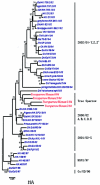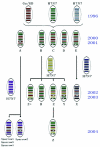New genotype of avian influenza H5N1 viruses isolated from tree sparrows in China
- PMID: 16306617
- PMCID: PMC1316012
- DOI: 10.1128/JVI.79.24.15460-15466.2005
New genotype of avian influenza H5N1 viruses isolated from tree sparrows in China
Abstract
The 2004 outbreaks of highly pathogenic avian influenza H5N1 disease in China led to a great poultry loss and society attention. A survey of avian influenza viruses was conducted on tree sparrows (Passer montanus) collected in China in 2004. Four viruses were isolated from free-living tree sparrows. The results of the whole-genome analysis indicated that an H5N1 virus with a new genotype is circulating among tree sparrows. The hemagglutinin and neuraminidase genes of the new genotype were derived from Gs/Gd/96-like viruses and the nuclear protein gene descended from the 2001 genotype A H5N1 viruses, while the other inner genes originated from an unknown influenza virus. In experimental infection, all four viruses were highly pathogenic to chickens but not pathogenic to ducks or mice. The four tree sparrow viruses were different from the 2003 tree sparrow strain (genotype Z) in Hong Kong. The results suggested that H5N1 viruses might be distributed widely in tree sparrows.
Figures









Similar articles
-
An H5N1 highly pathogenic avian influenza virus isolated from a local tree sparrow in Indonesia.Microbiol Immunol. 2011 Sep;55(9):666-72. doi: 10.1111/j.1348-0421.2011.00361.x. Microbiol Immunol. 2011. PMID: 21699556
-
Characterization of a highly pathogenic avian influenza H5N1 clade 2.3.4 virus isolated from a tree sparrow.Virus Res. 2010 Jan;147(1):25-9. doi: 10.1016/j.virusres.2009.09.014. Epub 2009 Oct 3. Virus Res. 2010. PMID: 19804800
-
Continued circulation in China of highly pathogenic avian influenza viruses encoding the hemagglutinin gene associated with the 1997 H5N1 outbreak in poultry and humans.J Virol. 2000 Jul;74(14):6592-9. doi: 10.1128/jvi.74.14.6592-6599.2000. J Virol. 2000. PMID: 10864673 Free PMC article.
-
[Avian influenza viruses isolated in Japan].Uirusu. 2005 Dec;55(2):231-7. doi: 10.2222/jsv.55.231. Uirusu. 2005. PMID: 16557008 Review. Japanese.
-
The genetics of highly pathogenic avian influenza viruses of subtype H5 in Germany, 2006-2020.Transbound Emerg Dis. 2021 May;68(3):1136-1150. doi: 10.1111/tbed.13843. Epub 2020 Sep 29. Transbound Emerg Dis. 2021. PMID: 32964686 Review.
Cited by
-
Risk factors for infectious diseases in backyard poultry farms in the Poyang Lake area, China.PLoS One. 2013 Jun 20;8(6):e67366. doi: 10.1371/journal.pone.0067366. Print 2013. PLoS One. 2013. PMID: 23840680 Free PMC article.
-
Characterization of avian H9N2 influenza viruses from United Arab Emirates 2000 to 2003.Virology. 2007 Apr 25;361(1):45-55. doi: 10.1016/j.virol.2006.10.037. Epub 2006 Dec 8. Virology. 2007. PMID: 17157891 Free PMC article.
-
Are passerine birds reservoirs for influenza A viruses?J Wildl Dis. 2014 Oct;50(4):792-809. doi: 10.7589/2014-02-043. Epub 2014 Aug 14. J Wildl Dis. 2014. PMID: 25121402 Free PMC article. Review.
-
A survey of avian influenza in tree sparrows in China in 2011.PLoS One. 2012;7(4):e33092. doi: 10.1371/journal.pone.0033092. Epub 2012 Apr 4. PLoS One. 2012. PMID: 22496742 Free PMC article.
-
Utilizing citizen science data to rapidly assess changing associations between wild birds and avian influenza outbreaks in poultry.Proc Biol Sci. 2024 Sep;291(2031):20241713. doi: 10.1098/rspb.2024.1713. Epub 2024 Sep 25. Proc Biol Sci. 2024. PMID: 39317317 Free PMC article.
References
-
- Chin, P. S., E. Hoffmann, R. Webby, R. G. Webster, Y. Guan, M. Peiris, and K. F. Shortridge. 2002. Molecular evolution of H6 influenza viruses from poultry in Southeastern China: prevalence of H6N1 influenza viruses possessing seven A/Hong Kong/156/97 (H5N1)-like genes in poultry. J. Virol. 76:507-516. - PMC - PubMed
-
- Chotpitayasunondh, T., S. Lochindarat, P. Srisan, K. Chokepaibulkit, J. Weerakul, M. Maneerattanaporn, and P. Sawanpanyalert. 2004. Cases of influenza A (H5N1)—Thailand, 2004. Morb. Mortal. Wkly. Rep. 53:100-102. - PubMed
-
- Claas, E., A. D. Osterhaus, R. van Beek, J. C. De Jong, G. F. Rimmelzwaan, D. A. Senne, S. Krauss, K. F. Shortridge, and R. G. Webster. 1998. Human influenza A H5N1 virus related to a highly pathogenic avian influenza virus. Lancet 351:472-477. - PubMed
-
- Fouchier, R. A., P. M. Schneeberger, F. W. Rozendaal, J. M. Broekman, S. A. Kemink, V. Munster, T. Kuiken, G. F. Rimmelzwaan, M. Schutten, G. J. Van Doornum, G. Koch, A. Bosman, M. Koopmans, and A. D. Osterhaus. 2004. Avian influenza A virus (H7N7) associated with human conjunctivitis and a fatal case of acute respiratory distress syndrome. Proc. Natl. Acad. Sci. USA 101:1356-1361. - PMC - PubMed
Publication types
MeSH terms
Substances
LinkOut - more resources
Full Text Sources
Medical

